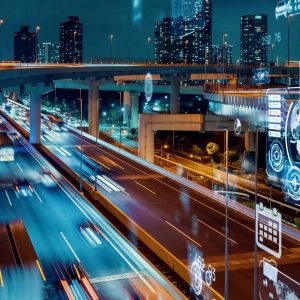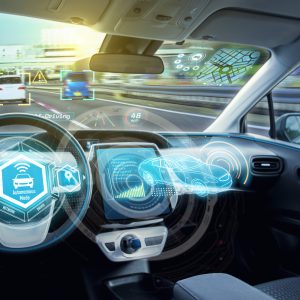Autonomous vehicles, often known as self-driving cars, are engineered and using AI to navigate and operate without human input. They are equipped with advanced artificial intelligence systems that enable them to perceive their environment and make decisions. These cars collect a large amount of visual information from cameras and sensors, which is then processed using sophisticated algorithms known as machine learning. This technology allows the car to learn from experience, much like a human does. Neural networks, which are complex structures modeled after the human brain, assist in interpreting this data and making informed decisions.
How Do Self-driving Cars work and use AI technologies?
The operation of self-driving cars using AI is fascinating. They continuously scan their surroundings, identifying everything from road signs to pedestrians. This is achieved through image recognition technology, which allows the car to ‘see’ and understand the world around it. The data gathered is immense, and it’s through this data that the car learns the best way to navigate roads safely.
Machine learning is at the heart of this process. It involves feeding the car’s computer system with vast amounts of data, which the car uses to improve its driving capabilities. Over time, the system becomes more refined and better at predicting and reacting to various driving scenarios. Neural networks play a crucial role here, as they process the data in a way that mimics human thought processes, enabling the car to make quick and accurate decisions.

What are the challenges of this AI technologies?
The ultimate goal of self-driving technology is to create a vehicle that can drive itself with full autonomy, without any need for human oversight. This could revolutionize transportation, making it safer and more efficient. However, there are still challenges to overcome, such as ensuring these cars can handle unexpected situations on the road with the same judgment a human driver would.
In summary, self-driving cars are a blend of advanced technologies working together to create a safe, autonomous driving experience. With each trip they take, these cars become smarter and more adept at handling the complexities of real-world driving. It’s a field that’s rapidly evolving, promising a future where cars are not just vehicles, but intelligent companions on the road.
How Neural Networks (AI) Do It’s Part in self-driving Cars?
Neural networks, the heart of AI systems are like smart detectives that spot patterns in information in a self-driving car. They get their clues from data given to them, which they learn from over time. This data is gathered by many self-driving cars sensors. Some sensors are like eyes (cameras), some work like bats using sound to see (radar), and some measure distance with light (lidar). These sensors are always watching and listening, picking up details about everything around, like traffic signals, the green trees, hard curbs, people walking, and signs on the streets. All this information helps the neural network get better at knowing what’s what in places where cars drive. It’s like learning to read a map of the road, but instead of paper, it’s all in the computer’s memory. This way, cars can understand the road and act smartly, keeping us safe.
A self-driving car creates a detailed guide of its area to grasp where it is and starts to figure out its journey. It has to pick the most secure and quickest ways to get to where it’s going, all while obeying the rules of the road and dodging any barriers. There’s also a system known as geofencing, which assists these smart cars in staying within certain areas that are set beforehand. This artificial intelligence powered technology in self-driving cars is quite clever; it uses sensors and cameras to see everything around it, like a mapmaker drawing every street and alley. It’s like the car has eyes, constantly watching for signs, signals, and any unexpected things that might be in the way, such as a fallen tree or a stray animal.
What are the benefits of using self-driving cars?
The car’s brain, which is a computer, takes all this information and makes decisions, just like a person would when driving, but it does it much faster and without getting tired or distracted. Geofencing, an artificial intelligence powered technology in self-driving car is just like drawing an invisible fence that tells the car, “You can go here, but not there,” making sure it stays where it’s supposed to. This helps a lot in places like cities, where there are lots of cars and people, and it’s easy to get lost or go somewhere you shouldn’t. All this smart technology makes self-driving cars very good at getting from one place to another safely and quickly, which is great for everyone on the road.
What is Geofencing in more details?
Geofencing in self-driving car is using the artificial intelligence, so it is like drawing invisible lines on a map. When a car crosses these lines, it can automatically send messages or warnings. This is possible because of GPS, which stands for Global Positioning System, or other similar technologies that know where the car is. Imagine setting up a special area on a map, and when the car goes in or out of this area, something happens automatically. For example, if a company has many cars, they can use geofencing to keep track of them all. It’s also helpful to make sure drivers are safe because the system can alert if a car goes somewhere it’s not supposed to go. This technology is becoming more common in cars today, and it’s very useful for managing lots of vehicles and keeping drivers safe on the road.
How does machine learning work in self-driving cars?
Waymo, a leader in autonomous driving technology, employs a variety of tools like sensors, lidar (a method to measure distances with laser light), and cameras. These instruments work together seamlessly, processing a vast amount of information rapidly to recognize all that surrounds the car. They can even anticipate the potential actions of nearby objects. This entire process occurs incredibly quickly, in mere moments. The growth and improvement of these systems are crucial; with each journey, they gather more information. This additional data is then fed into sophisticated deep learning algorithms. This could happen by the aid of machine learning (an AI powered technology) at the main part of the self-driving car system.
Over time, this allows the system to refine its ability to make decisions, resulting in smoother and more informed driving choices. As the system gains experience, much like a human learning a skill, it becomes more adept at navigating complex driving scenarios. This continuous learning process is vital for the advancement of self-driving car, ensuring they can handle the roads safely and efficiently. Simplifying this, imagine a new driver getting better with practice; similarly, the more Waymo’s system is on the road, the smarter it gets, leading to safer and more reliable driving without human intervention.
Autonomous cars in action
Waymo’s vehicles are designed with advanced technology to take you where you need to go. Here’s a simple explanation of how they operate:
Firstly, someone in the self-driving car, like the driver or a passenger, decides on a place to go. The vehicle’s smart system, – you say artificial intelligence at the core of the system – then figures out the best way to get there. On top of the car, there’s a spinning device that uses lasers to see all around, up to 60 meters away. It makes a moving picture in 3D of everything around the car. There’s also a special tracker on one of the back wheels that helps the car understand where it is by comparing its movements to the 3D picture.
To make sure the autonomous car knows how close things are, there are radar gadgets in the front and back that measure the space to objects near the car. The car’s brain, powered by AI, is linked to these radars and other sensors. It also uses information from Google’s Street View and cameras in the car to help it ‘see’ like a person. This AI in self-driving cars is quite smart; it can learn and make decisions, guiding the car’s movements, like turning the steering wheel or pressing the brakes.

The vehicle’s system also checks Google Maps to know about things on the road ahead, like signs or traffic lights. And if ever needed, there’s a special switch that lets a person take over driving the car. This way, Waymo ensures safety and control are always top priorities.
What are the underlying technologies used in the system?
To elaborate, the technology behind self-driving cars is quite sophisticated. It involves a combination of advanced software, detailed maps, and numerous sensors working in harmony. These sensors, such as cameras and radar, are the car’s eyes and ears, gathering data about the road, other vehicles, pedestrians, and various obstacles. However, these sensors are not foolproof. They can be affected by bad weather, poor lighting, or unexpected road conditions, which can lead to malfunctions or accidents. So here AI will come in handy, when other sensors get into problems, artificial intelligence can correct the data in someway.











